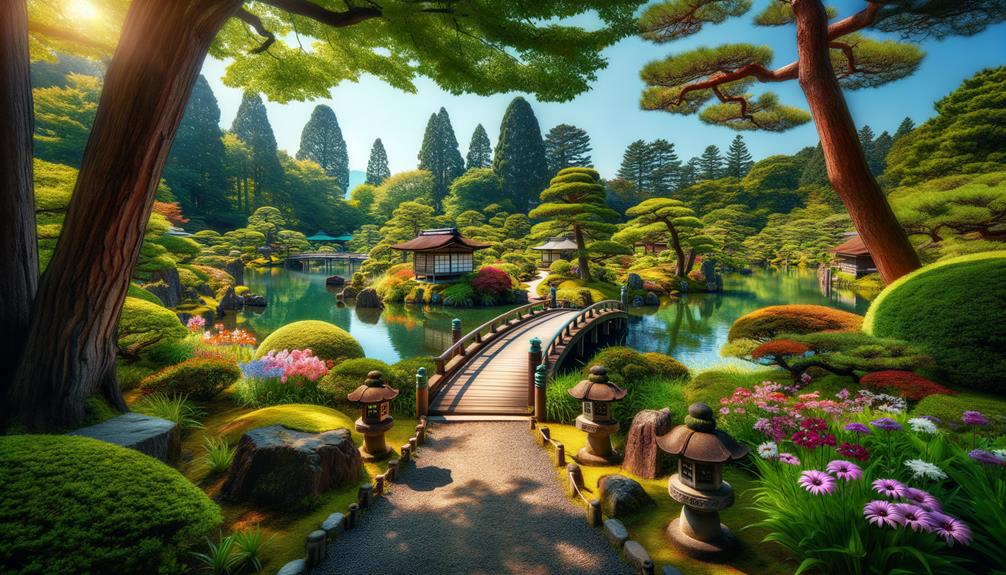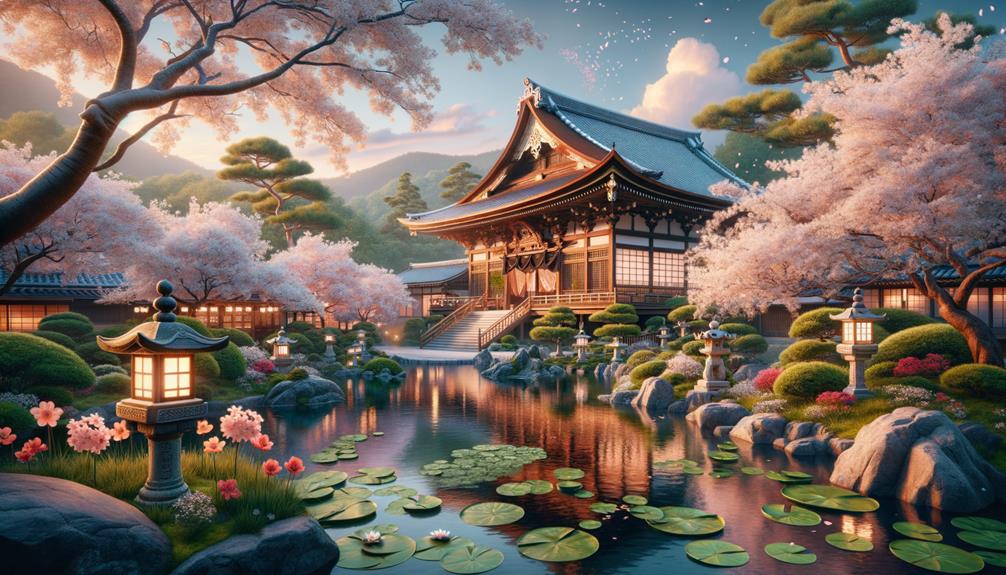Strolling through Kanazawa's Kenrokuen Garden, I was struck by how seamlessly nature and art come together. The Kotojitoro Lantern stood elegantly by Kasumigaike Pond, its two-legged form casting a timeless reflection on the water. Each bend in the path unveiled another carefully crafted scene, from the flowing waters of Midori Falls to the peaceful area around Seisonkaku Villa. As I took in the garden's six defining features, I found myself curious about how the Yukitsuri tradition changes the landscape in winter, hinting at seasonal wonders yet to be seen.
Overview of Kenrokuen Garden
Right next to Kanazawa Castle in Ishikawa, Kenrokuen Garden offers visitors a serene escape with its blend of natural beauty and traditional Japanese landscaping. As I strolled through the garden, I immediately felt a sense of peace. Kenrokuen, known as one of Japan's most stunning gardens, is designed for leisurely walks and quiet reflection.
Situated in Ishikawa Prefecture, the garden is renowned for its six defining features: spaciousness, seclusion, artificiality, antiquity, abundant water, and sweeping views. These elements come together to create a space that feels both vast and cozy.
Though its history spans several centuries, Kenrokuen has been open to the public since 1874. Walking along its well-kept paths, I was struck by the ponds mirroring the sky, the ancient stone lanterns, and the soothing sound of waterfalls. Each season brings its own unique beauty, from cherry blossoms in spring to vibrant autumn leaves and the tranquil, snow-covered scenes of winter.
At Kenrokuen Garden, time seems to pause, offering a peaceful retreat for mindfulness and relaxation in the heart of Ishikawa Prefecture.
Must-See Features
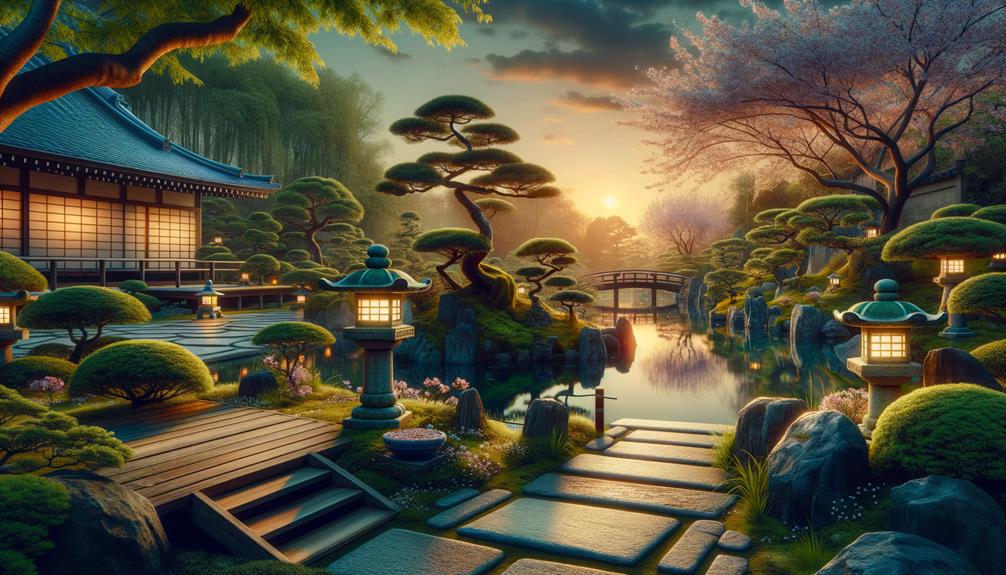
While wandering through Kenrokuen Garden, a few features really caught my eye. The water fountain powered by natural pressure from Kasumigaike Pond was ingeniously designed. The Kotojitoro Lantern, with its two-legged structure, added a unique traditional touch. Lastly, the Seisonkaku Villa, with its mix of architectural styles, offered a fascinating glimpse into Japan's historical design heritage.
Naturally-Powered Water Fountain
One of the most enchanting features of Kenrokuen Garden is its naturally-powered water fountain, a marvel of traditional Japanese engineering that works without electricity. Located below the calm Kasumigaike Pond, this fountain uses natural water sources and pressure to create a sustainable and captivating display, showcasing the ingenuity within this historic landscape.
As I walked through the garden, I was drawn to this blend of nature and artistry. The fountain's gentle, rhythmic flow adds a dynamic touch to the peaceful surroundings. I admired the innovative design, which reflects centuries-old techniques focused on sustainability and elegance. The water flows effortlessly, powered solely by the natural pressure from the pond above.
This fountain isn't just a visual treat; it's a profound cultural symbol. It embodies the Japanese commitment to harmony with nature, a philosophy deeply rooted in their garden designs. Standing there, I couldn't help but appreciate how this simple yet sophisticated feature captures the essence of traditional craftsmanship and ecological mindfulness.
In Kenrokuen Garden, every element tells a story, and the naturally-powered water fountain is a captivating chapter you shouldn't miss.
Kotojitoro Lantern Design
The Kotojitoro Lantern, with its unique two-legged design, stands out as a beautiful symbol of Kenrokuen Garden's charm and cultural significance. Walking through the garden, I was immediately drawn to this iconic lantern near the calm Kasumigaike Pond. Its design, featuring a horizontal bar connecting two vertical legs, exudes both elegance and a sense of timeless tradition.
Standing close to this piece, I could almost feel the echoes of history and artistry that define Kenrokuen Garden. The lantern's structure is not just visually pleasing but reflects the detailed attention that characterizes the entire garden. When night falls, the Kotojitoro Lantern lights up, casting a gentle glow over the pond and creating a magical atmosphere.
Visitors, including myself, are captivated by its distinct architectural style. The lantern design embodies the balance between nature and craftsmanship that Kenrokuen Garden is famous for. Each element of the garden, from its lanterns to its ponds, showcases the deep cultural insight and artistry of Japanese garden design.
Seisonkaku Villa Architecture
After admiring the Kotojitoro Lantern, I headed to the Seisonkaku Villa, a beautiful example of Edo-period architecture and craftsmanship. Built in 1863 by Lord Nariyasu Maeda, the villa honors the Maeda family's legacy and their commitment to traditional design. The two-story structure immediately drew me in with its mix of traditional and historical elements.
The first floor has a rustic feel, with wooden beams and tatami rooms that create a calm, almost meditative atmosphere. In contrast, the second floor is more refined, featuring intricate carvings and bright colors. This contrast not only showcases the versatility of Japanese architecture but also gives visitors a glimpse into the cultural richness of the Edo period.
Inside, Seisonkaku Villa serves as a museum, displaying beautiful dolls, kimono, and paintings. Each exhibit offers a unique look into the lifestyle and artistic tastes of the era. As I wandered through the villa, I felt a deep connection to Kanazawa's rich cultural heritage. It's a place where history comes alive through every wooden panel and painted screen, inviting visitors to step back in time.
Historical Significance
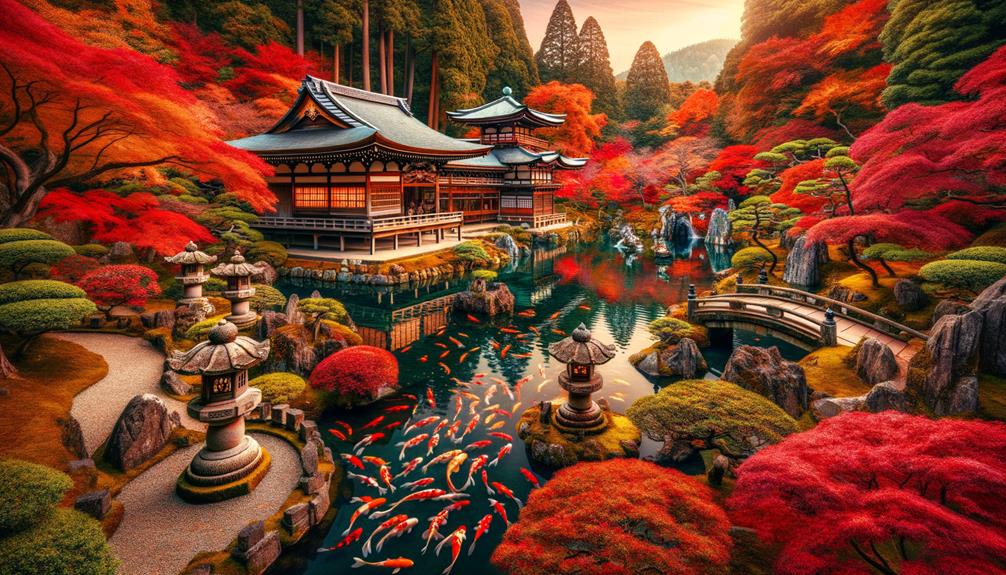
As I strolled through Kenrokuen, I was struck by how perfectly it captures the six qualities of an ideal garden: spaciousness, seclusion, artifice, antiquity, watercourses, and panoramas. The Maeda family's commitment over centuries has kept this cultural gem intact, making each visit feel like a journey back in time. The serene Kasumigaike Pond and Horai Island, representing eternal prosperity, stand as quiet reminders of the garden's rich history and deep symbolism.
Garden's Six Qualities
Strolling through Kenrokuen Garden, it's impossible not to be struck by its six distinct qualities: spaciousness, seclusion, artifice, antiquity, water features, and stunning views. Each aspect has been thoughtfully crafted by the Maeda family, showcasing their love for nature and cultural heritage.
As I walked across the wide lawns and along the winding paths, the garden's spaciousness gave me a feeling of freedom and peace. Secluded spots and shaded groves offered perfect places for quiet moments. The garden's artifice, evident in the carefully placed lanterns and bridges, showed the Maeda family's commitment to beauty.
Every ancient tree and stone in the garden whispered of its long history, making me feel part of something timeless. The water features, especially the calm Kasumigaike Pond and the symbolic Horai Island, added a soothing, almost meditative element to the experience. The magnificent views from different vantage points offered breathtaking sights of the garden's balanced mix of nature and human design.
Kenrokuen is more than just a garden; it's a living homage to the Maeda family's legacy and Japan's rich cultural past.
Maeda Family Legacy
Kenrokuen Garden is a testament to the Maeda family's lasting commitment and vision, turning their private sanctuary into one of Japan's most celebrated public spaces. Walking through the garden, you can sense the echoes of feudal times, where the Maeda family carefully designed each element to showcase both natural beauty and cultural sophistication. Since its creation in 1676, the garden has changed, but the spirit of its creators is still very much alive.
The Maeda family, once influential feudal lords of the Kaga Domain, poured their resources and artistic talents into this landscape. Initially part of Kanazawa Castle, the garden offered a peaceful escape from their political and military responsibilities. Renamed Kenrokuen in 1822, it was opened to the public in 1874, allowing people like me to enjoy its timeless allure.
Every path I walk and every pond I look at is a tribute to the Maeda family's legacy. Their dedication to maintaining and preserving Kenrokuen has ensured that this garden remains a living piece of history. It's more than just a garden; it's a glimpse into Japan's feudal past.
Symbolic Features
Kenrokuen's symbolic features, such as the Kasumigaike Pond and Horai Island, capture the garden's historical essence and timeless elegance. Walking through the garden, I feel the weight of centuries past. The pond and island represent eternal prosperity, reflecting the Maeda family's ambitions. As I stroll under the delicate petals of cherry blossoms and the shade of sturdy pine trees, the garden reveals its layered history.
Kenrokuen is a tribute to the art of Japanese garden design, embodying six essential characteristics:
- Spaciousness: The garden's wide-open spaces provide a sense of freedom and grandeur.
- Seclusion: Hidden corners and secluded paths offer moments of introspection.
- Artifice: Carefully constructed landscapes create a natural yet curated beauty.
- Antiquity: Historical structures and ancient trees connect visitors to the past.
Starting in 1676 and opening to the public in 1874, the garden has evolved through seasons and centuries. In spring, cherry blossoms paint the garden pink and white, while in winter, the snow-covered pine trees showcase the yukitsuri technique, protecting the branches from heavy snowfall. Kenrokuen's symbolic features don't just tell a story—they invite you to be part of it.
Seasonal Highlights
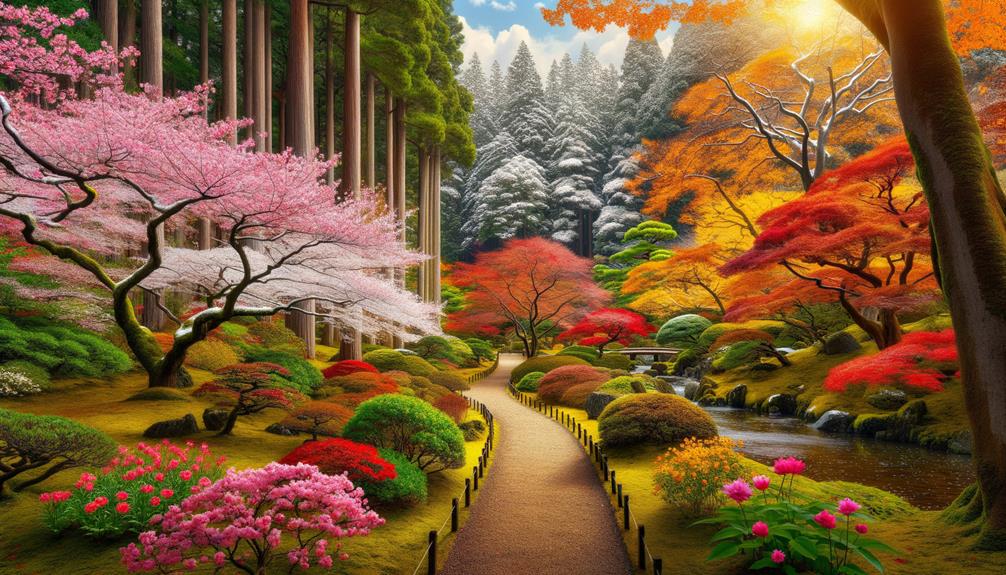
Walking through Kenrokuen Garden, the changing seasons bring a vibrant mix of colors and peaceful views that draw you in. In spring, the garden comes alive with plum and cherry blossoms, creating a soft palette of pinks and whites along the paths. The air smells sweet, and the petals fall gently, almost like snow.
As early summer sets in, azaleas and irises start to bloom, adding bright purples and greens to the scene. The tranquil ponds reflect these colors, making the garden feel calm and soothing. The soft hum of insects and the rustling leaves offer a perfect escape from daily life.
Autumn turns Kenrokuen into a brilliant display of red and yellow leaves. The maples and ginkgos light up the garden, their reflections dancing on the water. Every turn reveals a new burst of color, inviting quiet walks and moments of reflection.
Each season at Kenrokuen provides a different experience, showcasing nature's changing beauty in Kanazawa. It's a timeless journey through Japan's rich culture.
Yukitsuri Tradition
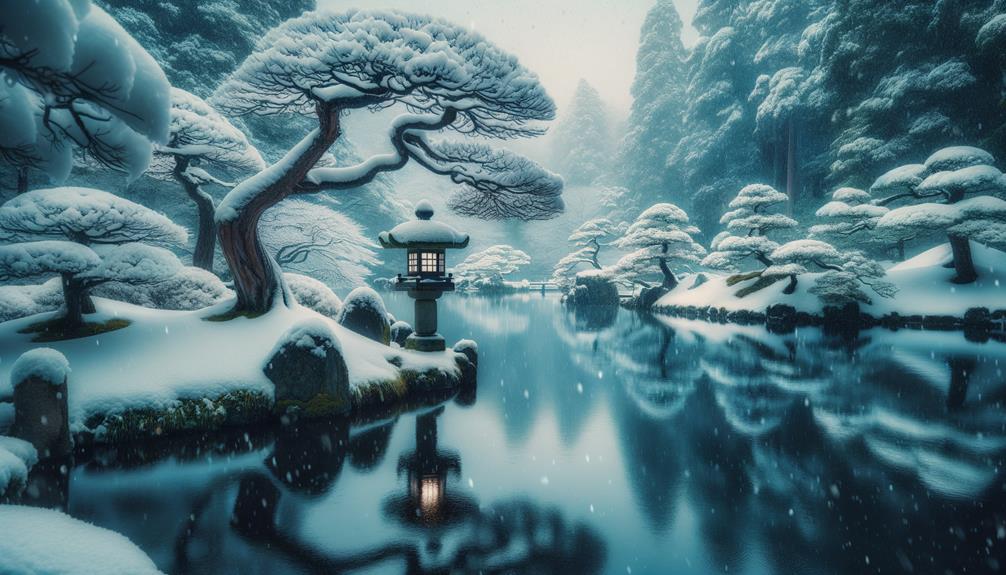
Walking through Kenrokuen Garden in winter, you can't miss the yukitsuri structures. These ropes, spread out from tree branches like delicate spider webs, protect them from heavy snow. The conical rope designs are not only visually stunning but also keep the garden's trees safe from the snow's weight.
The yukitsuri tradition runs from November 1 to March 15, ensuring the trees stay intact throughout winter. The process highlights the balance between nature and human care. As you stroll through the garden, the sight of yukitsuri enhances the winter landscape, making you feel as if you've entered a serene, snow-globe world.
Here's how it works:
- Ropes are attached to tree trunks.
- The ropes fan out to the branches.
- A supportive conical shape is formed.
- This setup prevents branches from breaking.
Seeing this practice offers insight into how the Japanese maintain their landscapes. Yukitsuri in Kenrokuen Garden is not just about function; it's a testament to the dedication to preserve beauty and tradition through the seasons. For those who value freedom, there's something profoundly inspiring about this blend of care and craftsmanship.
Access and Transportation
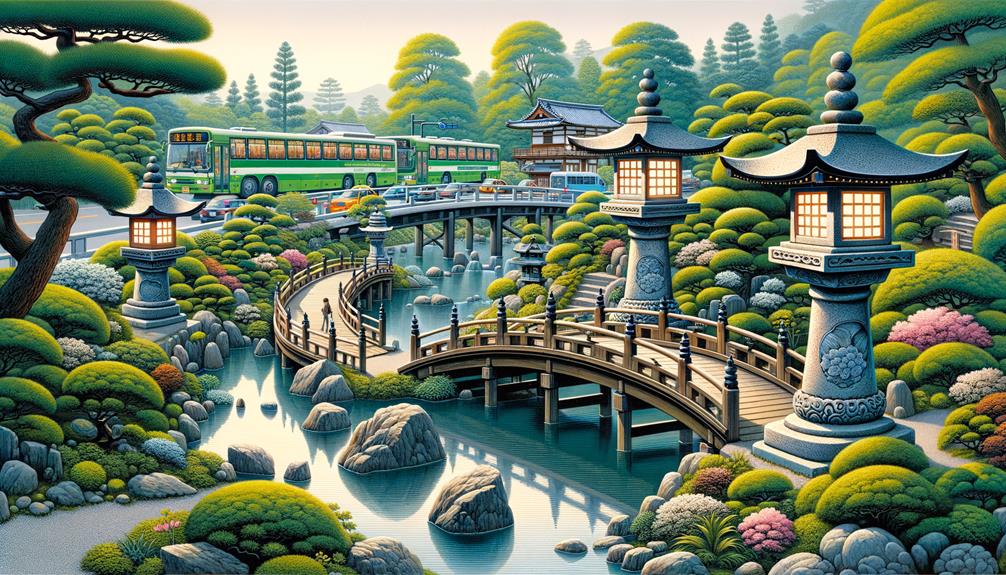
Visiting Kenrokuen Garden is a breeze. Just catch a bus from Kanazawa Station for a short 20-minute ride, costing only 200 yen. The trip is smooth and gives you a quick view of the city. If you have a JR Rail Pass, you're in luck—the JR buses heading to Korinbo make it even easier to get there.
Kenrokuen Garden is quite accessible. The garden opens from 7:00 to 18:00 during spring and summer, and from 8:00 to 17:00 in autumn and winter, giving you plenty of time to enjoy its beauty. It felt freeing to explore at my own pace.
Being next to Kanazawa Castle is also a plus, making it easy to visit other attractions nearby. Before my visit, I checked the garden's official website for details on fees and hours, which helped a lot. Kenrokuen Garden's ease of access definitely adds to its charm, letting you fully enjoy its peaceful atmosphere.
Nearby Attractions
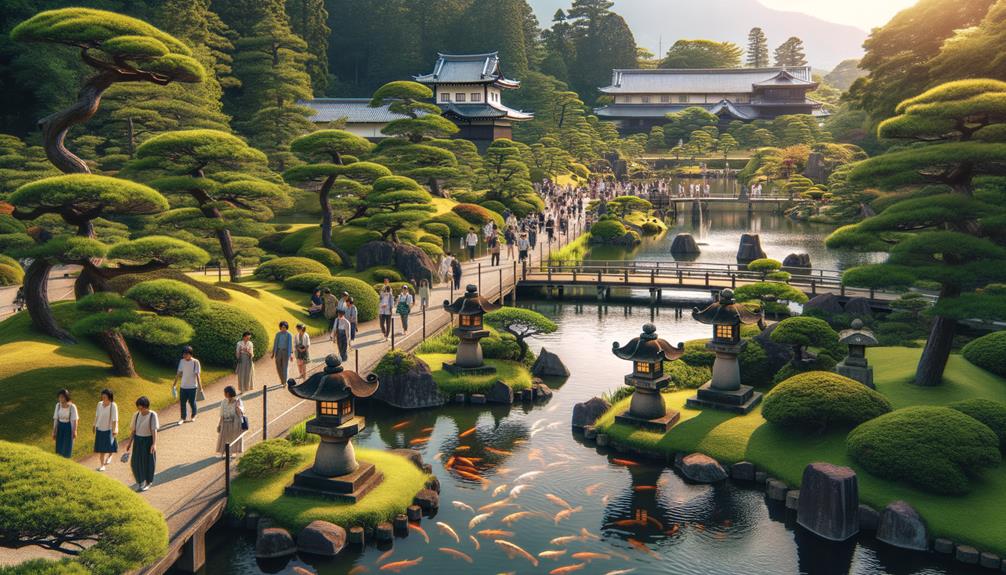
Right in the center of Kanazawa, Kenrokuen Garden is conveniently close to Kanazawa Castle, blending historical exploration with natural beauty. Recognized as one of Japan's top three gardens, Kenrokuen's allure is heightened by its surroundings. Just a short walk away, Kanazawa Castle stands as a majestic reminder of Japan's feudal era, offering insights into the architecture and life of that time.
Beyond Kenrokuen and the castle, there are several must-see spots:
- Nagamachi Samurai District: Walking through this preserved area, you get a real sense of the Edo period with its narrow lanes and earthen walls that capture the samurai spirit.
- 21st Century Museum of Contemporary Art: In stark contrast to the historical sites, this museum features modern art in a unique circular building.
- Higashi Chaya District: Known for its teahouses, this district lets you experience traditional geisha culture amidst charming wooden buildings.
- Omicho Market: This bustling market is perfect for sampling local seafood and produce and is full of energy.
Each of these attractions adds a unique layer to Kanazawa's rich history, making it a city where past and present coexist beautifully.
Guided Tour Options
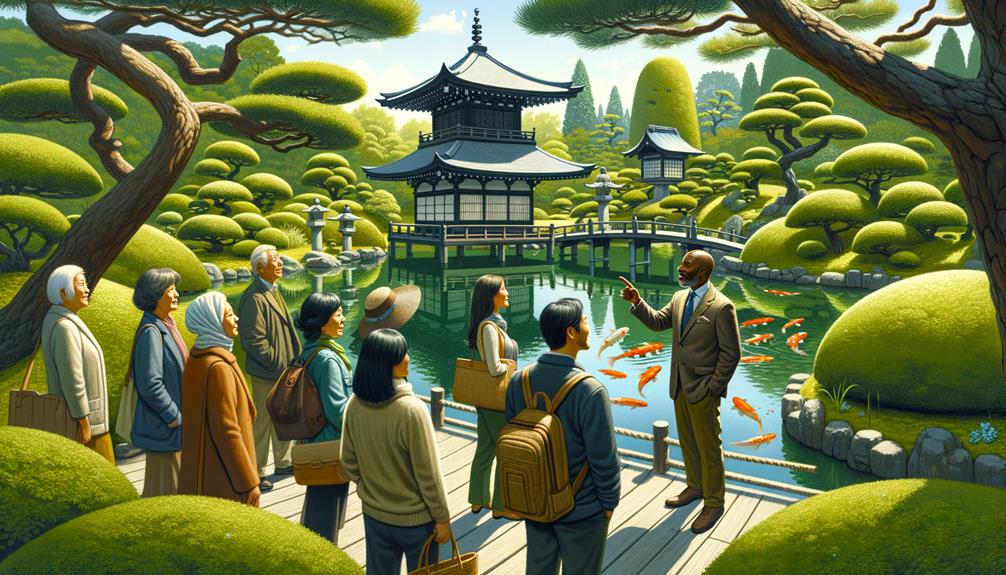
Exploring Kanazawa's attractions is a richer experience with the variety of guided tours available. Whether you're into history, photography, or nature, there's a tour just for you. When I visited Kenrokuen Garden, I chose a half-day private tour, and it made a huge difference. The guide had so many interesting stories about the garden's history and design, making every corner fascinating.
Here's a quick look at the guided tour options:
| Tour Type | Duration | Highlights |
|---|---|---|
| Private Tours | Half-day/Full-day | Personalized guide, deep cultural insights |
| E-bike Tours | Half-day | Samurai district, geisha insights |
| Photography Tours | Varies | Pro photographers, memorable captures |
One standout experience was the e-bike tour. The mix of historical sights and modern convenience was great. Pedaling through the samurai district and seeing glimpses of geisha culture gave me a deeper understanding of Kanazawa. For those who love taking photos, the photography tours are fantastic. Professional photographers guide you to the best spots in Kenrokuen Garden, ensuring you go home with amazing photos and wonderful memories.
Frequently Asked Questions
How Long to Spend in Kenrokuen Garden?
Spending 1-2 hours in Kenrokuen Garden might feel like just a moment. However, during cherry blossom season, it's easy to lose track of time and spend an entire morning or afternoon there.
How Much Does It Cost to Go to Kenrokuen Garden?
Visiting Kenrokuen Garden costs 320 yen for adults and 100 yen for kids aged 6 to 17. If you're 65 or older, you can enter for free. The garden's seasonal beauty makes it worth every yen.
How Do I Get to Kenrokuen From Kanazawa Station?
Just catch a 20-minute bus ride from Kanazawa Station for 200 yen, and you'll be at Kenrokuen Garden in no time. It's a quick and easy trip to one of the most beautiful spots in the city.
Is Kenrokuen Garden Free?
Kenrokuen Garden charges a small entry fee. Adults pay 320 yen, children 100 yen, and seniors can enter for free with an ID. The fee helps maintain this beautiful, historic garden, which is open all year for everyone to enjoy.

